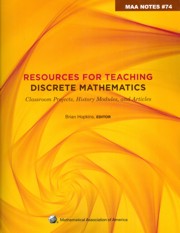Book contents
- Frontmatter
- Introduction
- Dedication
- Contents
- I Classroom-tested Projects
- The Game of “Take Away”
- Pile Splitting Problem: Introducing Strong Induction
- Generalizing Pascal: The Euler Triangles
- Coloring and Counting Rectangles on the Board
- Fun and Games with Squares and Planes
- Exploring Recursion with the Josephus Problem: (Or how to play “One Potato, Two Potato” for keeps)
- Using Trains to Model Recurrence Relations
- Codon Classes
- How to change coins, M&M's, or chicken nuggets: The linear Diophantine problem of Frobenius
- Calculator Activities for a Discrete Mathematics Course
- Bulgarian solitaire
- Can you make the geodesic dome?
- Exploring Polyhedra and Discovering Euler's Formula
- Further Explorations with the Towers of Hanoi
- The Two Color Theorem
- Counting Perfect Matchings and Benzenoids
- Exploring Data Compression via Binary Trees
- A Problem in Typography
- Graph Complexity
- II Historical Projects in Discrete Mathematics and Computer Science
- III Articles Extending Discrete Mathematics Content
- IV Articles on Discrete Mathematics Pedagogy
- About the Editor
The Two Color Theorem
from I - Classroom-tested Projects
- Frontmatter
- Introduction
- Dedication
- Contents
- I Classroom-tested Projects
- The Game of “Take Away”
- Pile Splitting Problem: Introducing Strong Induction
- Generalizing Pascal: The Euler Triangles
- Coloring and Counting Rectangles on the Board
- Fun and Games with Squares and Planes
- Exploring Recursion with the Josephus Problem: (Or how to play “One Potato, Two Potato” for keeps)
- Using Trains to Model Recurrence Relations
- Codon Classes
- How to change coins, M&M's, or chicken nuggets: The linear Diophantine problem of Frobenius
- Calculator Activities for a Discrete Mathematics Course
- Bulgarian solitaire
- Can you make the geodesic dome?
- Exploring Polyhedra and Discovering Euler's Formula
- Further Explorations with the Towers of Hanoi
- The Two Color Theorem
- Counting Perfect Matchings and Benzenoids
- Exploring Data Compression via Binary Trees
- A Problem in Typography
- Graph Complexity
- II Historical Projects in Discrete Mathematics and Computer Science
- III Articles Extending Discrete Mathematics Content
- IV Articles on Discrete Mathematics Pedagogy
- About the Editor
Summary
Summary
The purpose of this project is to help students prove that, under certain conditions, a map can be two-colored. There are at least four ways to approach this problem; the proofs vary in difficulty and use several techniques from discrete mathematics, including induction, structural induction, graphs, decision trees, and parity checks.
Notes for the instructor
There are two parts to this project, and each part guides the students through two different proofs of the result. Part I is fairly straightforward and could be assigned as a homework problem or as an in-class group activity. Part II is more challenging and is suitable for a longer-term (group) project, ideally after the students have completed Part I.
Solution I.1 is the easiest and most intuitive, and gives a good example of an inductive argument in a simple geometric setting. Solution I.2 avoids induction by using a parity check argument.
Solution II.1 involves some intuition about the topology of curves in the plane. To develop this intuition, students might want to experiment with loops of string (possibly even knotted). The trickiest part of the proof involves showing that a smoothing can always be chosen so that the curve remains connected. This property (and the basis of the inductive argument) can be discovered by constructing a binary decision tree, where each branch gives the result of smoothing a vertex in two different ways.
- Type
- Chapter
- Information
- Resources for Teaching Discrete MathematicsClassroom Projects, History Modules, and Articles, pp. 125 - 130Publisher: Mathematical Association of AmericaPrint publication year: 2009



